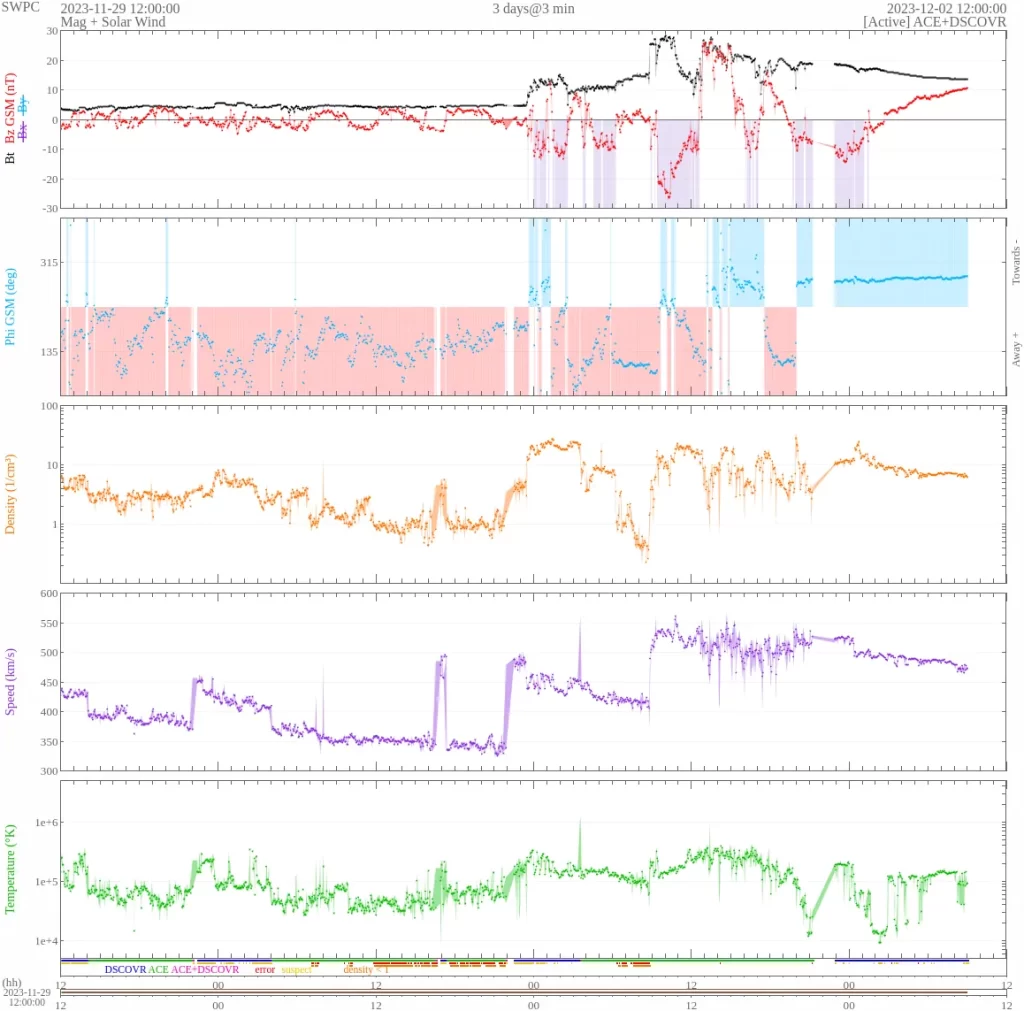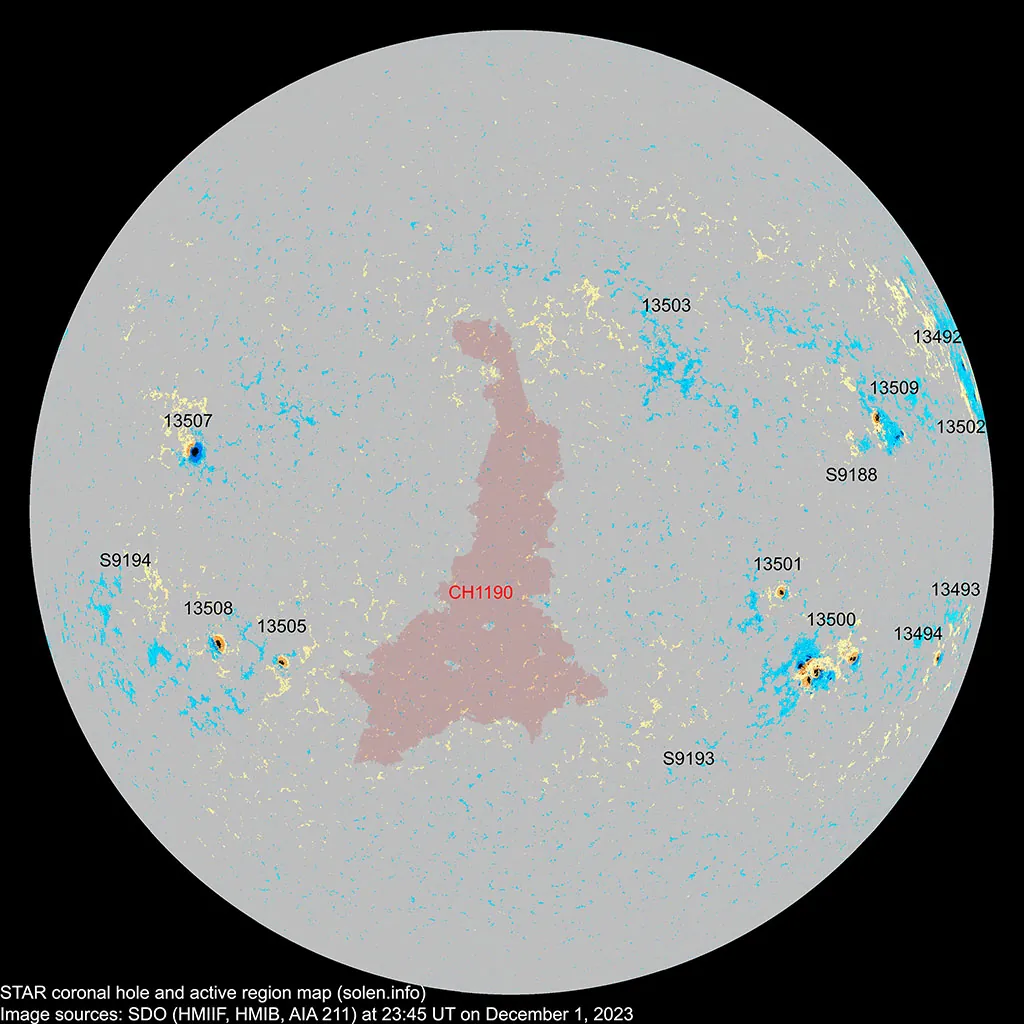Multiple coronal mass ejections (CMEs) produced on November 27 and 28, 2023, impacted Earth on November 30 and December 1, sparking G3 – Strong geomagnetic storm. Similarly to the last G3 storm, on November 5, spectacular aurora sightings were reported from both hemispheres.
The solar wind parameters observed during the 24-hour period ending at 00:30 UTC on December 2, 2023, signaled the arrival of multiple CMEs, initially detected on November 27 and 28.
The first notable CME impact, which occurred at 23:37 UTC on November 30, led to an increase in solar wind velocity from about 335 km/s (208 mph) to approximately 440 km/s (273 mph). Concurrently, the total magnetic field strength showed a significant rise from 5 nT to 12 nT.
A second CME, produced by M9.8 solar flare on November 28, was observed at 08:53 UTC on December 1, causing further escalations in solar wind speeds from approximately 406 km/s (252 mph) to near 510 km/s (317 mph).


During this event, the total magnetic field also experienced an increase, moving from 15 nT to 25 nT. Throughout the remainder of the observation period, the total field fluctuated between 13 nT and 28 nT, while solar wind speeds varied from around 480 km/s (298 mph) to 560 km/s (348 mph). The Bz component of the magnetic field ranged around +/-26 nT, with a variable Phi angle.
Similarly to the last G3 – Strong geomagnetic storm, on November 5, spectacular aurora sightings were reported from both hemispheres.
KABOOOOOM!!!
Full Frontal G3 Aurora hits NZ with all it’s insane beauty!!
All-nighter spent capturing the goodness and first time the Corona has been seen and captured here this solar cycle!!
LFG 🔥🔥🔥@TamithaSkov pic.twitter.com/uRJGi2t6zn
— LARRYN | SR💎 Edition Part 2 Coming soon 🔥🔥 (@shadowanshadenz) December 1, 2023
OMG!! I just saw Red Aurora shooting right through this 22° moon halo!! 5:30am near Lacombe Alberta #aurora #TeamTanner @treetanner @TamithaSkov @chunder10 @scottrockphoto @mikesobel @spann @MatthewCappucci @weathernetwork @StoraserUKEU @weatherchannel pic.twitter.com/wEgPMCuWC5
— Dar Tanner (@dartanner) December 1, 2023
Okay, I couldnt resist. I had to edit one photo tonight. Goodnight from Fairbanks! pic.twitter.com/2TnhKMMFa3
— Kris Luckenbach (@KrisLuckPhoto) December 1, 2023
Northern lights/Aurora borealis today in Mongolia 🇲🇳
Aurora appears crimson red when solar particles react with oxygen at high altitudes of over 241 km, where the air is thinner. Red is considered the rarest colour of the Northern Lights.#ТуйлынТуяа #bloodaurora #полярноесияние pic.twitter.com/Sh6sHnPn1O— Bileg (@eebileg) December 1, 2023
Downloaded version of “red dawn”. The red were SO VIBRANT. ❤️ @TamithaSkov @spacewxwatch @CharlesPeekWX #aurora #northernlights #tweeraurora #SpaceWeather #spacewx #wiwx @TravelWI @DoorCountyPulse pic.twitter.com/5VvJLyeyJZ
— MaryBeth Kiczenski (@MKiczenski) December 1, 2023
Timelapse of all the photos I took tonight. Down at Island Point, just south of Mandurah.
Biggest aurora I’ve seen! Could see it moving w/ the naked eye, w/ massive beams appearing suddenly & a very obvious pink hue across the sky.
Just amazing!#Perth #WesternAustralia #Aurora pic.twitter.com/lvEZbUYJjd— Shelley ⚓️ (@wheresshelly) December 1, 2023
Forecasts indicate that the influence of these CMEs is expected to persist through midday on December 2, followed by a gradual recovery towards nominal conditions through December 3. Early on December 4, a negative polarity coronal hole high-speed stream (CH HSS) is anticipated to become geoeffective, potentially increasing solar wind speeds to the range of 600 – 700 km/s (373 – 435 mph), based on historical recurrence patterns.
In terms of geospace impact, the geomagnetic field was observed at active to G3 – Strong storm levels due to the CME arrivals from November 27 and 28.
The forecast suggests that the geomagnetic field will experience unsettled to G2 – Moderate storm levels, with a possibility of G3 – Strong storming on December 2 as the effects of the CMEs continue. A return to quiet to unsettled levels is expected on December 3 as the activity slowly wanes.
Unsettled to G2 – Moderate storm levels are likely again on December 4 as a negative polarity CH HSS is expected to become geoeffective.


References:
1 Forecast Discussion – Issued 2023 Dec 02 0030 UTC -Prepared by the U.S. Dept. of Commerce, NOAA, Space Weather Prediction Center
Featured image credit: Katarina Srsenova via SpaceWeather. Captured on December 1, 2023 from Iceland.
If you value what we do here, create your ad-free account and support our journalism.
Multiple CMEs heading toward Earth, G3 – Strong Geomagnetic Storm Watch in effect
Wednesday, November 29, 2023
M9.8 solar flare erupts from geoeffective Region 3500, Earth-directed CME likely
Tuesday, November 28, 2023
Global SAR arc outbreak: Geomagnetic storm leads to rare SAR arc sightings across the globe
Wednesday, November 8, 2023
Geomagnetic storm reaches G3 – Strong level after dual CME impact
Monday, November 6, 2023
Large filament eruption produces partial-halo CME, impact to Earth expected on November 5
Saturday, November 4, 2023
Revised NOAA forecast predicts stronger Solar Cycle 25, peak in 2024
Friday, October 27, 2023
Rare pure sine wave detected in Earth’s magnetic field
Thursday, October 19, 2023
